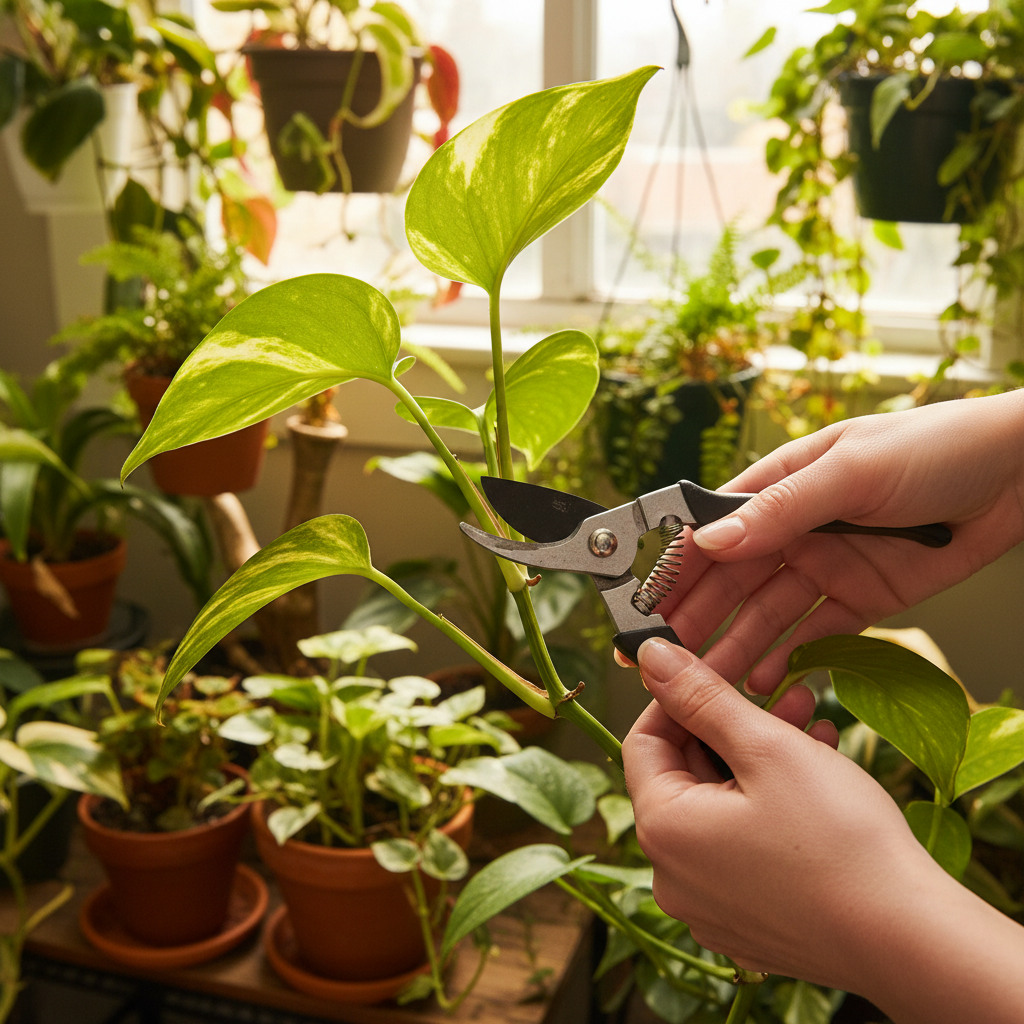
Table of Contents
Introduction
Have you ever dreamed of multiplying your favorite plants without having to purchase new ones? Imagine transforming a single plant into a flourishing collection, right from your home garden. Whether you’re a seasoned gardener or a passionate plant enthusiast, learning how to propagate plants opens the door to endless possibilities for growing and sharing greenery.
Plant propagation is an essential skill that allows gardeners to reproduce plants from a variety of methods, ensuring the continuous growth and renewal of your garden. This practice is not just cost-effective but also gives you the satisfaction of nurturing new life from existing plants. With the increasing interest in home gardening worldwide, more people are realizing the power of propagation to enhance their green spaces sustainably and creatively.
Understanding the basics of plant propagation can feel overwhelming at first, but it’s easier than it seems. From cuttings and division to layering and grafting, each technique has specific benefits suited to different types of plants and conditions. Many gardeners find joy in selecting the right propagation method for their favorite species, and with the right guidance, you too can achieve success in multiplying your plants.
Whether you want to start with popular easy-to-grow plants or experiment with more advanced techniques, this guide is designed to support your journey. We acknowledge that gardeners often face concerns such as the best timing for propagation, avoiding common pitfalls like root rot or pest issues, and caring for newly propagated plants to ensure healthy growth. Our approach addresses all these points with practical advice and encouragement to help you build confidence and enjoy your gardening experience thoroughly.
What You’ll Learn in This Guide
This comprehensive guide on how to propagate plants covers everything you need to know to begin or refine your propagation skills. Here’s an overview of the key topics and techniques we will explore together:
- Understanding the Basics: Learn what plant propagation is and why it is valuable. We will introduce you to common propagation methods and explain their advantages in simple terms so you can choose the best approach for your gardening goals.
- Common Methods of Plant Propagation: Dive into detailed explanations of popular techniques such as propagation by cuttings, division, layering, seed propagation, and grafting. Each method will be described step-by-step, enabling you to try them confidently.
- Tools and Materials Needed: Discover the essential tools and supplies you need at home for successful propagation, including pruning shears, rooting hormones, pots, and more. We’ll also touch on optional supplies that can enhance your results.
- Care and Problem Prevention: Understand how to care for your newly propagated plants properly and avoid common problems such as pests, diseases, overwatering, and failed root development. Practical tips will guide you through maintaining plant health.
In addition, we’ll highlight the best plants for beginners, discuss the ideal timing for propagation, and provide troubleshooting advice to help you overcome challenges you may encounter. Our goal is to equip you with all the knowledge and confidence needed to successfully propagate plants and enjoy the rewards of your efforts.
As you continue reading, you will find detailed insights into each propagation method, helpful care instructions, and examples of plants suited to different techniques. If you’re new to gardening, understanding the basics and starting with recommended plants can make your experience much more enjoyable and rewarding.
This guide is crafted to accompany you every step of the way, transforming propagation from a daunting task into an exciting and fulfilling gardening adventure. Whether you want to expand your indoor plant collection or grow a beautiful outdoor garden, the techniques shared here will empower your green thumb and deepen your connection with nature.

Having gained a foundational understanding of plant propagation and its various benefits, it is now essential to delve deeper into the practical techniques that gardeners and plant enthusiasts commonly use. Successful propagation not only allows for the multiplication of plants but also fosters a stronger connection between gardener and garden. With this knowledge, enthusiasts can confidently replicate their favorite plants, improve garden aesthetics, and even save money by growing new plants instead of purchasing them. The following discussion will explore the most popular propagation methods and the essential tools required to perform them effectively at home.
Common Methods of Plant Propagation
Plant propagation employs various techniques that suit different plant types and gardener preferences. Understanding these methods is key to choosing the right one for your plants. Common methods include propagation by cuttings, division, layering, seed propagation, and grafting. Each technique offers unique advantages and is applicable in different scenarios, making it important to master the basics of each to increase success rates. To fully grasp these methods, it helps to start with the basics of gardening which lay the foundation for healthy growth and propagation success.
Propagation by cuttings is one of the most accessible and popular methods among gardeners. It involves taking a portion of a plant, such as a stem, leaf, or root, and encouraging it to form roots independently. Division, on the other hand, involves separating established plants into smaller, manageable sections, ideal for plants with clumping growth habits. Layering uses the plant’s natural ability to develop roots from stems still attached to the parent plant, while propagation by seeds involves germinating plant seeds under optimal conditions. For more advanced horticulturists, grafting combines parts of two plants to grow as one, commonly used in fruit tree propagation.
Key Aspects of Common Propagation Methods
Each method has particular nuances to consider for optimal outcomes. Here are the essential points for each technique:
- Propagation by Cuttings: This method requires carefully selecting healthy stems, leaves, or roots and preparing them properly before planting. Using rooting hormones can significantly increase success by stimulating root growth. Proper potting mediums that retain moisture yet drain well are crucial to avoid rot.
- Division: Best suited for plants that naturally grow in clumps, such as hostas and ferns. When dividing, gently separate the root ball into smaller sections ensuring each part has sufficient roots and shoots for independent growth. This technique rejuvenates older plants and encourages vigorous new growth.
- Layering: Simple layering involves bending a low stem to the ground and covering it with soil to encourage root formation while serpentine layering uses multiple points along a stem. This method is beneficial for plants difficult to root from cuttings and provides a high success rate as the new plant remains attached to the parent until roots develop.
- Propagation by Seeds: Selecting quality seeds and understanding seed dormancy and germination requirements are crucial. Providing consistent warmth, moisture, and light conditions encourages healthy germination. This method offers the opportunity to grow many plants at once, though it takes longer to reach maturity.
Tools and Materials Needed for Successful Plant Propagation
Having the right tools and materials is fundamental to ensuring propagation success. Proper equipment not only simplifies the process but also promotes healthier, disease-free plants. Beginners and seasoned gardeners alike benefit from assembling a toolkit that supports various propagation methods. Essential tools include sharp pruning shears for clean cuts, pots or containers suited to rooting environments, and rooting hormones to enhance root development. Besides basics, additional supplies like heating mats to maintain soil warmth and humidity domes to preserve moisture can improve the rooting environment, especially in cooler climates.
It’s also important to have a suitable planting medium that provides adequate drainage and aeration, preventing root rot and facilitating robust root systems. Labeling tools help keep track of different plant varieties and propagation dates, which is helpful when working with multiple species or methods concurrently. Acquiring these tools creates an efficient workspace that supports both frequent and experimental propagation.
Important Considerations for Propagation Tools and Materials
Preparation and proper use of tools impact the success rate of propagated plants significantly. Here are key points to consider:
- Basic Tools: Pruning shears should be sharp and sterilized to prevent disease transmission between plants. Choosing the right size and shape of pots helps maintain optimal moisture levels. Rooting hormones can be found in powder, gel, or liquid form and are selected based on the propagation method and plant type.
- Planting Medium: Use a sterile, well-draining medium like a mix of peat, perlite, and vermiculite. This mixture balances moisture retention and airflow, preventing fungal issues and supporting healthy root growth.
- Optional Supplies: Heat mats provide consistent warmth to accelerate root initiation, especially helpful in cooler regions or seasons. Humidity domes trap moisture around cuttings or seedlings, mimicking a greenhouse environment to reduce water stress and increase survival rates.
- Organization Tools: Labels and markers keep your propagation efforts organized, particularly useful when propagating multiple plant species. Keeping records helps track what works best for each plant variety, facilitating ongoing learning and improvement.

Conclusion
Embarking on the journey of plant propagation opens a world of gardening possibilities that are both rewarding and sustainable. Throughout this guide, we’ve explored a variety of propagation techniques—from the simplicity of cuttings and division to the more intricate methods like layering, seed germination, and grafting. Each method offers unique advantages tailored to specific plant types, growing conditions, and gardener preferences, making propagation a versatile skill for anyone interested in expanding their green space without continually purchasing new plants. The knowledge that you can nurture new life from your existing plants empowers you to embrace a deeper connection to your garden and experience the joy of growth and renewal firsthand.
Key to successful propagation is understanding the needs of each plant and selecting the right method that encourages healthy root and shoot development. Proper preparation, such as choosing quality tools like sharp pruning shears, using rooting hormones where appropriate, and ensuring a well-draining planting medium, can significantly improve your success rates. Additionally, maintaining an optimal environment with adequate moisture, light, and temperature support fosters strong, healthy plantlets ready to thrive once separated from their parent plants.
Propagation is not only a cost-effective way to multiply your plants but also an opportunity to practice patience and attentiveness, vital traits in gardening. By mastering these techniques, you gain the ability to rejuvenate tired or overgrown plants, preserve treasured varieties, and share your love of gardening with friends and family through plant gifts or swaps.
When it comes to putting these skills into action, begin with beginner-friendly plants such as pothos, spider plants, and succulents that readily root from cuttings. Gather your essential tools, set up a clean workspace, and follow step-by-step procedures tailored to your chosen method. Pay close attention to the care your new plants require—watering appropriately, providing sufficient light, and knowing the correct time to transplant—to ensure they flourish. Keep a simple record of your propagation attempts, noting what works best for each plant, which will help you refine your approach over time.
Remember, propagation is as much about experimentation and enjoyment as it is about success. Embrace the learning curve and don’t be discouraged by setbacks—they offer valuable insights that bring you closer to becoming a confident propagator. With a little patience and persistence, you’ll watch your plant collection grow, knowing each one started as a small cutting, division, or seed nurtured by your care.
Ultimately, learning to propagate plants enhances your gardening experience by combining creativity, sustainability, and the satisfaction of nurturing life from root to bloom. So, take the plunge, try various propagation methods, and let your green thumb flourish—it’s a deeply fulfilling adventure that connects you meaningfully to the natural world.
